Defined benefit and defined contribution plans are the two main types of retirement plans offered by employers in both the public and private sectors for their employees. Defined benefit plans are what most of us would think of as a traditional pension plan.
Defined contribution plans include the popular 401(k) plan as well as 403(b) and 457 plans. Due to a number of factors including cost, defined contribution plans have replaced defined benefit as the retirement plan of choice for many employers.
What is a Defined Benefit Plan?
A defined benefit plan defines the retirement benefit that employees will receive. The benefit is based on factors such as years of service with the employer as well as their lifetime earnings. Defined benefit pension plans are still common in the public sector, but there has been a significant decline in the number of private sector employers still offering them.
With a defined benefit plan, employers provide the funding for the plan. In some cases, employees may be able to make contributions in addition to what the employer makes.
One of the reasons for the decline in popularity of defined benefit plans is that they are expensive to run and administer. For example, defined benefit plans need to have an actuarial valuation done each year. This valuation gauges the funding the plan as a percentage of the funding requirements of the governmental entities that regulate funding levels for public and private sector plans. Plans must be funded to a certain level, if a plan is underfunded the employer will need to make extra contributions to bring the funding level up.
In the case of pension plans offered by a private sector company, their pension obligations are a liability on the company’s balance sheet, just like a business loan. Defaulting on their pension obligations can put a company into bankruptcy.
Companies also must pay an insurance premium to the Pension Benefit Guaranty Corporation (PBGC) that is based on several factors including the plan’s funding levels. The PBGC is set up to cover pension payments to employees when their employer’s plan defaults and is a federally chartered corporation.
Employees are entitled to a benefit from their pension after they become vested, this usually occurs after five years of service. Pension benefits are often taken as a monthly annuity payment, though in some cases the plan will allow for a lump-sum payment which can be taken as a withdrawal or rolled over to an IRA.
Pension payments are generally taxable for federal taxes, though payments may be exempt from state taxes in some states. It's always best to consult a tax professional regarding taxes on pension payments.
What is a Defined Contribution Plan?
Unlike a defined benefit plan, the benefits earned in a defined contribution plan are a function of the participant’s contributions to the plan and the growth of the investments they make inside of the plan. In some cases, employers may make matching or other contributions to the plan on the employee’s behalf.
The 401(k) plan is perhaps the most well-known type of defined contribution plan, 403(b) plans and 457 plans which are both prevalent in the public sector are also types of defined contribution plans.
Employees can contribute up to $20,500 for 2022, with an extra catch-up contribution of $6,500 available for those employees who are 50 or over. Most defined contribution plans offer a menu of investment options, usually a number of mutual funds, that participants can choose from. Some plans offer a Roth option as well.
Contributions to a traditional 401(k) or other defined contribution plan are generally made on a pre-tax basis. In some cases after-tax contributions can be made to these accounts. Contributions to a Roth account are made after-tax.
Distributions from a traditional 401(k) and other traditional versions of retirement accounts are taxable. If you take a distribution prior to age 59 ½ you will generally be subject to a 10% penalty. Any amount tied to an after-tax contribution to the plan will not be subject to taxes. Rolling the balance over to an IRA or another retirement plan can preserve the tax-deferred nature of the account.
Distributions from a Roth 401(k) are not subject to taxes as long as the five-year rule for contributions has been satisfied and if you are at least age 59 ½.
Defined contribution plans are subject to required minimum distribution rules, this includes Roth defined contribution accounts as well. These RMDs on Roth accounts are not taxed. They can be avoided by rolling the Roth account balance to a Roth IRA when leaving your employer.
Differences Between Defined Benefit and Defined Contribution Plans
There are a number of differences between defined benefit and defined contribution plans.
| Defined contribution plan | Defined benefit plan | |
|---|---|---|
Investment risk | Born by the employee | Born by the employer |
Contributions | Made by employees, though some employers may make matching or other contributions as well. | Made by the employer. |
How is the benefit determined? | The employee’s retirement benefit is a function of the amount they’ve contributed to the plan, any employer contributions and the performance of their money based on how they have chosen to invest this money. | The employee’s benefit is typically a function of their tenure with the employer. |
How do participants take their benefits? | Money can be withdrawn from the plan or rolled over to an IRA or other retirement upon leaving the company. | Typically benefits are taken as an annuity in the form of monthly payments. In some cases the benefit can be taken as a lump-sum payment that can be distributed to the employee or rolled over to an IRA or other retirement plan. |
Defined benefit plans define your future benefit upfront or at least the parameters on which that benefit will be based. Retirement benefits from a defined contribution plan are a function of contributions to the account by the plan participant and any employer contributions, along with the investment returns earned by the plan participant.



